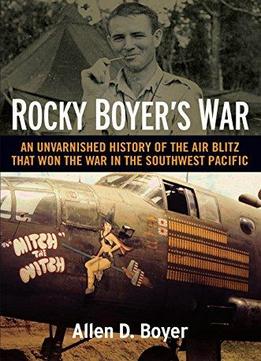
Rocky Boyer's War
by Allen D. Boyer /
2017 / English / AZW3
3.9 MB Download
This book gives a counterpoint history – wry, keen-eyed, sometimes disgruntled – of the hard-fought, brilliant campaign that won World War II in the Southwest Pacific. It draws on the diary of an officer who knew its airfields and scarred beachheads, and its narrative is wrapped around a scandal and two battles.
During 1944, Douglas MacArthur’s army fought its way from New Guinea to the Philippines. In New Guinea, discarding pre-war doctrine, Allied air commander George Kenney planned and ran an “air blitz” offensive. Kenney’s Fifth Air Force drove forward like a tank army, crash-landing in open country, seizing terrain, bulldozing new airfields, winning air control, and moving forward.
At airfields on the front line, First Lieutenant Roscoe A. Boyer – Rocky Boyer – kept the radios working for the 71st Tactical Reconnaissance Group, a fighter-bomber unit. This book draws on his diary. Diaries were forbidden, but Rocky kept one – full of casualties, accidents, off-duty shenanigans, and rear-area snafus. He had friends killed when they shot it out with Japanese anti-aircraft gunners, or when their bombers vanished in bad weather. He wrote about wartime camp life – at Nadzab, New Guinea, the largest air base in the world, part Scout camp and part frontier boomtown. He knew characters worthy of Catch-22: combat flyers who played contract bridge, officers who played office politics, black quartermasters, and chaplains who stood up to colonels, when a promotion party ended with drunken gunplay and dynamite. His group stepped in against Japanese counterstrikes, sharp, sudden fights against enemy warships.
• Off the island of Biak, in June 1944, the 17th Tactical Reconnaissance Squadron, flying B-25’s, attacked Japanese destroyers carrying enemy reinforcements. In 90 seconds, the squadron won 60 Distinguished Flying Crosses, 19 of them posthumous.
• On the beachhead at Mindoro, south of Manila in December 1944, Rocky fought in what Kenney called “the wildest scramble of the war”: a grim evening when the airfield was hit by Japanese bombers and shelled by a Japanese war fleet.
This is a narrative of the war as airmen lived it, not a day-by-day, blow-by-blow verbatim transcript of a wartime diary. Rocky’s experience of life on the front line gives from-the-bottom-up detail to the framework of Kenney’s air blitz.











